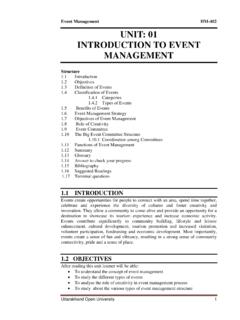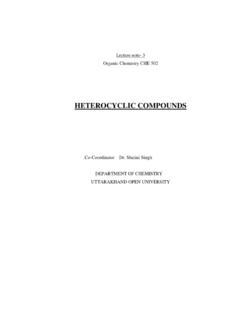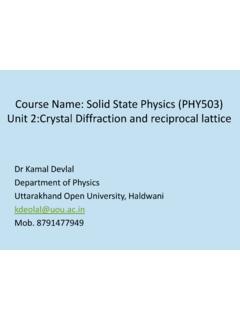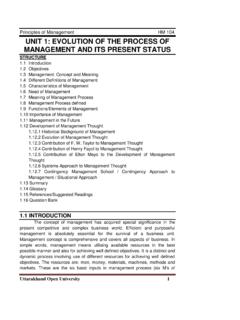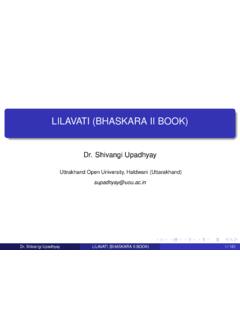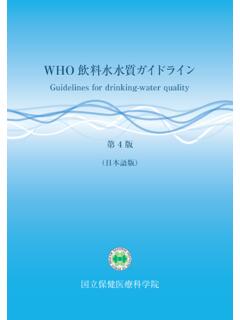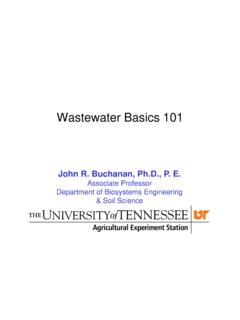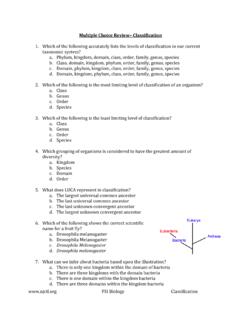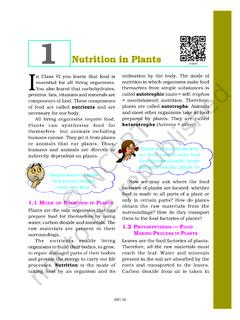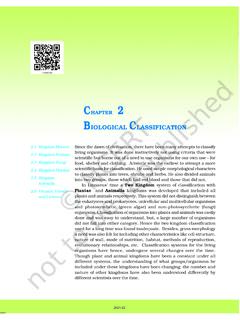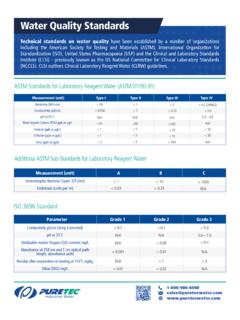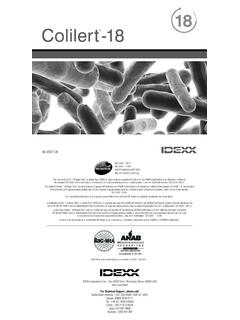Transcription of B. Sc. I YEAR PRACTICAL ZOOLOGY - Uttarakhand Open …
1 PRACTICAL ZOOLOGY DEPARTMENT OF SCHOOLUTTARAKHAND OPEN UNIVERSITY BSCB. Sc. I YEAR PRACTICAL ZOOLOGY DEPARTMENT OF ZOOLOGY SCHOOL OF SCIENCES Uttarakhand OPEN UNIVERSITY BSCZO- 104 PRACTICAL ZOOLOGY Uttarakhand OPEN UNIVERSITY Board of Studies and Programme Coordinator Unit writing and Editing Editor Dr. Mahesh Kumar Department of ZOOLOGY MB College Haldwani (Kumaun University Nainital) Uttarakhand (India). Writer Dr. Suneeta Negi Associate Professor Department of ZOOLOGY College Kotdwar (HNB Garhwal)University Department of ZOOLOGY School of Sciences Uttarakhand Open University Haldwani (Nainital) Tripathi Assistant Professor Department of ZOOLOGY MB College Haldwani (Kumaun University Nainital) Uttarakhand (India).
2 Board of Studies Prof. Department of ZOOLOGY Gurukul Kangri University Haridwar Principal Scientist, Directorate of Coldwater Fisheries Research (ICAR) Bhimtal (Nainital). Dr. Shyam Department of ZOOLOGY School of Sciences, Uttarakhand Open University Prof. Department of ZOOLOGY DSB Campus,Kumaun University, Nainital Prof. Retd. Prof. & Principal Department of ZOOLOGY , MB College Haldwani Nainital. Programme Coordinator Dr. Shyam Department of ZOOLOGY School of Sciences, Uttarakhand Open University Haldwani, Nainital Shruti Saxena Assistant Professor Department of ZOOLOGY SGRRPG College, Dehradun Uniyal Assistant Professor Department of ZOOLOGY SGRRPG College, Dehradun Assistant Professor Department of ZOOLOGY College Agustyamuni ``````` Course Title and Code : PRACTICAL ZOOLOGY (BSCZO 104) ISBN : 978-93-85740-56-5 Copyright : Uttarakhand Open University Edition : 2017 Published By.
3 Uttarakhand Open University, Haldwani, Nainital- 263139 BSCZO-104 PRACTICAL ZOOLOGY DEPARTMENT OF ZOOLOGY SCHOOL OF SCIENCES Uttarakhand OPEN UNIVERSITY Phone No. 05946-261122, 261123 Toll free No. 18001804025 Fax No. 05946-264232, E. mail: Contents Course 4: PRACTICAL ZOOLOGY Course code: BSCZO104 Credit: 3 Unit number Block and Unit title Page number Block 1 Museum Specimen Study 1-288 1 Protozoa: Amoeba, Paramecium, Euglena, Ceratium and Noctiluca. Plasmodium, Monocystis, Trypanosoma, Leishmania, Ent-amoeba and Giardia. 1-33 2 Porifera: Leucosolenia, Grantia, Scypha, Hyalonema, Euplectella, Spongilla and Euspongia.
4 L. S. and T. S. of Scypha & Grantia. 34-55 3 Coelentrata: Medusa of Obelia, larval stages of Aurelia, Physalia, Porpita, Vellela, Tubipora, Millepora, Aurelia, Gorgonium, Pennatua, Alcyonium, Adamsia. 56-85 4 Platyhelminthes: Dugesia, Fasciola and sections of Fasciola and Taenia, mature and gravid proglottids of Taenia, developmental stages of Fasciola and Taenia. 86-110 5 Nematoda: Ascaris, Ancylostoma, Dracunculus, Wuchereria, Trichinella, Schistosoma and Enterobius. 111-131 6 Annelida: Nereis, Heteronereis, Aphrodite, Arenicola, Pheretima, Pontobdella, and Hirudinaria. Transverse sections of Nereis and Hirudinaria, Trochophore larva of Nereis, Parapodium of Nereis and Heteronereis 132-160 7 Arthropoda : Limulus, Spider, Palamnaeus, Apus, Lepas, Balanus, Sacculina, Palaemon, Lobster, Eupagurus, Crab, Lepisma, Odontotermes, Pediculus, Schistocerca, Papilio, Bombyx, Xenopsylla, Apis, Julus and Scolopendra.
5 Crustacean larvae (Nauplius, Zoea, Megalopa and Mysis), mosquito larva & pupa. Sacculina, Lice, flea, bedbug, tick and mites 161-229 8 Mollusca: Chiton, Dentalium, Sepia, Patella, Pila, Turbinella, Aplysia, Slug, Snail, Mytilus, Octopus. Transverse sections of Lamellidens and Glochidium larva. 230-265 9 Enchinodermata: Pentaceros, Asterias, Ophiothrix, Echinus, Holothuria and Antedon. Pedicellariae of Star fish. 266-288 Block 2 Experimentation 289-448 10 Study of living animals: Amoeba, Paramecium, Euglena, Hydra and rectal ciliates 289-320 11 Minor dissections /Permanent slide preparation: Permanent preparations / Minor dissections of the following: Paramecium Porifera: Sponge spicules and gemmules.
6 Coelenterates: Obelia colony, Obelia medusa. Arthropoda: Mouth parts of honey bee, butterfly, cockroach and grasshopper. 321-354 12 Cytological study: a. Study of mitosis and meiosis using available material. b. Study of permanent slides showing stages of cell division, giant chromosome, , mitochondria, Golgi body etc 355-409 13 Genetics experiment: Experimentation on Mendelian and non Mendelian inheritance, study of mutants of Drosophila through charts/photographs. 410-448 ZO-104: PRACTICAL ZOOLOGY Uttarakhand Open University Page 1 UNIT 1: PROTOZOA (STUDY OF PERMANENT SLIDES) Contents Objectives General Character & Classification Study of Protozoan s:- Amoeba and Paramecium Euglena Ceratium & Noctiluca Plasmodium & Trypnosoma , Entamoeba and Giardia Summary Glossary Readings ZO-104.
7 PRACTICAL ZOOLOGY Uttarakhand Open University Page 2 : To study General characters of Phylum Protozoa and its classification up to order. Study of permanent slides & study of Protozoan s with particular reference to Amoeba, Paramecium, Ceratium, Noctiluca , Euglena, Plasmodium , Monocystis, Trypnosoma, Leishmania , Entamoeba and Giardia . The Protozoa are heterogeneous assemblage of some 50,000 cellular or single- cell organism found worldwide in most habitats. Protozoa means first animal the simplest form of animal life. Protozoa are unicellular microorganisms (eukaryotes) that lack cell walls. They are found in marine habitat or soil, in fresh water bodies, symbiotic, some forms are parasites in other organisms.
8 Protozoa depends on nutrition, temperature, pH, and some depends on sunlight. Protozoa were defined as unicellular protists with animal-like behavior, such as movement. Protozoa were regarded as the partner group of protists to protophyta, which have plant-like behavior, photosynthesis. The term protozoan has become highly problematic due to the introduction of modern ultra structural, biochemical, and genetic techniques, which have showed that the group does not form a clade as required by modern classifications. Modern unicellular clades within Eukaryotes which may be viewed as approximately collectively replacing the class of protozoa include: Excavata, Amoeba, Chromalveolata and Rhizaria.
9 Protozoan s are usually single-celled heterotrophic eukaryotes containing non-filamentous structures that belong to any of the major lineages of protists. They are restricted to moist or aquatic habitats ( , they are obligate aquatic organisms). Many protozoan species are symbionts, some are parasites, and some are predators of feces bacteria and algae. There are an estimated 50,000 protozoan species. ZO-104: PRACTICAL ZOOLOGY Uttarakhand Open University Page 3 The Protozoa are considered to be a subkingdom of the kingdom Protista, although in the classical system they were placed in the kingdom Animalia.
10 More than 50,000 species have been described, most of which are free-living organisms; protozoa are found in almost every possible habitat. The fossil record in the form of shells in sedimentary rocks shows that protozoa were present in the Pre-Cambrian era. Anton van Leeuwenhoek was the first person to see protozoa, using microscopes he constructed with simple lenses. Between 1674 and 1716, he described, in addition to free-living protozoa, several parasitic species from animals, and Giardia lamblia from his own stools. General Characters of phylum Protozoa:- 1. Protozoa are microscopic animalcules with very simple organization.
